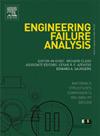管道周向焊缝气孔缺陷处氢原子扩散与分布的有限元模拟
IF 5.7
2区 工程技术
Q1 ENGINEERING, MECHANICAL
引用次数: 0
摘要
评价含孔缺陷管道周焊缝在气态氢环境下的氢脆敏感性,有助于混氢管道的安全运行。本研究建立了缺陷-力学-氢扩散耦合的三维有限元模型,以确定孔洞缺陷位置、大小和循环加载频率对孔洞点阵和阱中氢浓度的影响。结果表明,晶格点处的氢原子浓度分布与静水应力分布相似,阱点处的氢原子浓度分布与塑性应变分布相似。大多数氢原子驻留在晶格位而不是位错阱中。焊接过程中受约束条件的影响,孔区的静水应力和塑性应变随孔位置的变化而变化。WL-4和WL-5孔隙区域(即填充层)的氢原子浓度较高,容易发生氢致开裂。孔隙缺陷处的应变水平随孔隙尺寸的增大而显著增加,同时阱处的氢浓度升高。当孔径为1mm时,孔区的氢浓度达到峰值。甚至更小的孔缺陷(直径为0.7 mm)也会导致氢气富集。循环内压降低了孔隙区的静水应力水平和总氢浓度。在波动内压下,低频载荷对管道接头的结构完整性和抗氢脆性能的威胁最大。本文章由计算机程序翻译,如有差异,请以英文原文为准。
Finite element modeling of hydrogen atom diffusion and distribution at pore defects in circumferential welds of pipelines
Assessing the hydrogen embrittlement (HE) susceptibility of circumferential welds of pipelines with pore defects in gaseous hydrogen environments contributes to the safe operation of hydrogen-blended pipelines. A three-dimensional finite element model coupling defect-mechanics-hydrogen diffusion was developed in this study to determine the variation of hydrogen concentration in both lattice and trap sites in the pore region, influenced by pore defect location, size, and cyclic loading frequency. Results show that the distribution of the hydrogen atom concentration at lattice sites resembles the distribution of hydrostatic stress and distribution at trap sites resembles the distribution of plastic strain. Most hydrogen atoms reside in lattice sites rather than dislocation traps. The hydrostatic stress and plastic strain in the pore region change with the pore location due to the constraint conditions during the welding process. The hydrogen atom concentration in pore region at WL-4 and WL-5 (i.e., the filling layers) is relatively high, making these regions susceptible to hydrogen-induced cracking. The strain level at pore defects increases significantly with pore size, accompanied by a rise in hydrogen concentration at trap sites. When the pore diameter is 1 mm, the hydrogen concentration in the pore region reaches its peak level. Even smaller pore defects (with diameter is 0.7 mm) can result in hydrogen enrichment. Cyclic internal pressure reduces the hydrostatic stress level and total hydrogen concentration in the pore region. Under fluctuating internal pressure, low-frequency loading poses the greatest threat to the structural integrity and hydrogen embrittlement resistance of pipeline joints.
求助全文
通过发布文献求助,成功后即可免费获取论文全文。
去求助
来源期刊

Engineering Failure Analysis
工程技术-材料科学:表征与测试
CiteScore
7.70
自引率
20.00%
发文量
956
审稿时长
47 days
期刊介绍:
Engineering Failure Analysis publishes research papers describing the analysis of engineering failures and related studies.
Papers relating to the structure, properties and behaviour of engineering materials are encouraged, particularly those which also involve the detailed application of materials parameters to problems in engineering structures, components and design. In addition to the area of materials engineering, the interacting fields of mechanical, manufacturing, aeronautical, civil, chemical, corrosion and design engineering are considered relevant. Activity should be directed at analysing engineering failures and carrying out research to help reduce the incidences of failures and to extend the operating horizons of engineering materials.
Emphasis is placed on the mechanical properties of materials and their behaviour when influenced by structure, process and environment. Metallic, polymeric, ceramic and natural materials are all included and the application of these materials to real engineering situations should be emphasised. The use of a case-study based approach is also encouraged.
Engineering Failure Analysis provides essential reference material and critical feedback into the design process thereby contributing to the prevention of engineering failures in the future. All submissions will be subject to peer review from leading experts in the field.
 求助内容:
求助内容: 应助结果提醒方式:
应助结果提醒方式:


